Subsection of Roman Times:
A weblog of links to and abstracts from academic presentations on the Roman Empire
Tuesday, December 30, 2003
Just Wars and the Roman Empire
"The earliest mention of distinction between 'just war' (bellum justum) and 'unjust war' (bellum injustum) can be traced back to the Roman Empire. As long as the Roman Emperors had not embraced Christianity, the Church upheld a pacifistic posture and even forbade Christians to enlist as soldiers. After Christianity had become the official religion of the Roman Empire in the days of Constantine, the Church was compelled to modify its view about war. From that point onwards, the Christians were required to shed their blood for the Empire. The Church had to find a moral ground for this change and this was done by Saint Augustine. He enunciated that every war was a lamentable phenomenon, but the wrong suffered at the hands of the enemy imposed 'the necessity of waging just wars'. This was later refined by Saint Thomas Aquinas."
Monday, December 29, 2003
Roman silver hoard to be featured exhibit in Basel, Switzerland
 "Pieces of treasure hidden by the Romans 1,650 years ago as Germanic tribes stormed their northern Swiss fort at Augusta Raurica, have been reunited and put on display for the first time.
"Pieces of treasure hidden by the Romans 1,650 years ago as Germanic tribes stormed their northern Swiss fort at Augusta Raurica, have been reunited and put on display for the first time.
Some 270 precious items including silver platters, dishes, utensils and coins, are on show amid tight security at the Museum of the Roman town of Augusta Raurica, in Basel."
"The objects date back to the tumultuous era between 294 and 350 AD. The name Marcellianus appears on 13 items. It is possible that he and an unnamed owner buried their belongings together and only Marcellianus labelled what was his."
"Both men were undoubtedly army officers. An inscription on one of the dishes shows Marcellianus to have been a tribune – a unit commander or staff officer. His candelabrum, made to be packed together like a telescope, hints at a life of frequent travel. "
"Marcellianus apparently served with the imperial court as the emperor moved about the Balkans and westwards to Gaul."
"One of his bowls is from Thessalonica and is a typical gift of the emperor to loyal followers. Another dish celebrates the tenth jubilee of the reign of Emperor Constantine. "
"The maker’s marks on the Achilles dish and the “Euticus” dish also indicate that they are gifts from the emperor."
Wednesday, December 17, 2003
The History of Roman Beast Hunts
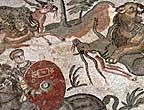 According to the 1875 Dictionary of Greek and Roman Antiquities by John Murray:
According to the 1875 Dictionary of Greek and Roman Antiquities by John Murray:
We do not know on what occasion a venatio was first exhibited at Rome; but the first mention we find of any thing of the kind is in the year B.C. 251, when L. Metellus exhibited in the Circus 142 elephants, which he had brought from Sicily after his victory over the Carthaginians, and which were killed in the Circus according to Verres, though other writers do not speak of their slaughter (Plin. H.N. viii.6). But this can scarcely be regarded as an instance of a venatio, since the elephants are said to have been only killed because the Romans did not know what to do with them, and not for the amusement of the people. There was, however, a venatio in the later sense of the word in B.C. 186, in the games celebrated by M. Fulvius in fulfilment of the vow which he had made in the Aetolian war; in these games lions and panthers were exhibited (Liv. xxxix.22). It is mentioned as a proof of the growing magnificence of the age that in the Ludi Circenses, exhibited by the curule aediles P. Cornelius Scipio Nasica and P. Lentulus B.C. 168, there were 63 African panthers and 40 bears and elephants (Liv. xliv.18). From about this time combats with wild beasts probably formed a regular part of the Ludi Circenses, and many of the curule aediles made great efforts to obtain rare and curious animals, and put in requisition the services of their friends (compare Caelius's letter to Cicero, ad Fam. viii.8). Elephants are said to have first fought in the Circus in the curule aedileship of Claudius Pulcher, B.C. 99, and twenty years afterwards, in the curule aedileship of the two Luculli, they fought against bulls (Plin. H.N. viii.7). A hundred lions were exhibited by Sulla in his praetorship, which were destroyed by javelin-men sent by king Bocchus for the purpose. This was the first time that lions were allowed to be loose in the Circus; they were previously always tied up (Senec. de Brev. Vit. 18). The games, however, in the curule aedileship of Scaurus B.C. 58 surpassed anything the Romans had ever seen; among other novelties he first exhibited an hippopotamos and five crocodiles in a temporary canal or trench (euripus, Plin. H.N. viii.40). At the venatio given by Pompey in his second consulship B.C. 55, upon the dedication of the temple of Venus Victrix, and at which Cicero was present (Cic. ad Fam. vii.1), there was an immense number of animals slaughtered, among which we find mention of 600 lions, and 18 or 20 elephants: the latter fought with Gaetulians, who hurled darts against them, and they attempted to break through the railings (clathri) by which they were separated from the spectators (Senec. l.c.; Plin. viii. 7.20). To guard against this danger Julius Caesar surrounded the arena of the amphitheatre with trenches (euripi).
In the games exhibited by J. Caesar in his third consulship, B.C. 45, the venatio lasted for five days and was conducted with extraordinary splendour. Camelopards or giraffes were then for the first time seen in Italy (Dion Cass. xliii.23; Suet. Jul. 39; Plin. H.N. viii.7; Appian, B. C. ii.102; Vell. Pat. ii.56
). Julius Caesar also introduced bull-fights, in which Thessalian horsemen pursued the bulls round the circus, and when the latter were tired out, seized them by the horns and killed them. This seems to have been a favourite spectacle; it was repeated by Claudius and Nero (Plin. H.N. viii.70; Suet. Claud. 21 ; Dion Cass. lxi.9). In the games celebrated by Augustus, B.C. 29, the hippopotamos and the rhinoceros were first exhibited, according to Dion Cassius (li.22), but the hippopotamos is spoken of by Pliny, as mentioned above, in the games given by Scaurus. Augustus also exhibited a snake 50 cubits in length (Suet. Aug. 43), and thirty-six crocodiles, which are seldom mentioned in spectacles of later times (Dion Cass. lv.10).
See: http://www.ukans.edu/history/index/europe/ancient_rome/E/Roman/Texts/secondary/SMIGRA%2A/Venatio.html
I also searched the web hoping to find a copy of Dr. Chris Epplett’s dissertation “The 'Creation' of the Roman Beast-Hunts” but I was unsuccessful. Here is an abstract:
The Roman beast-hunts (venationes), despite being popular arena spectacles, have generally received far less scholarly attention than the gladiatorial games with which they were associated. While numerous attempts have been made by modern scholars to explain the origin and purpose behind gladiatorial combat in the Roman empire, this and other aspects of the venationes have been relatively ignored by academics (Jennison's Animals for Show and Pleasure in Ancient Rome, written over 60 years ago, is a notable exception).
Antecedents for beast-hunts have been identified in Greek and Italic contexts, but the increasing violence of these events in the Late Republic can plausibly be linked to contemporary developments in gladiatorial combats. In my paper I investigate closely the process by which animal processions became animal slaughters. I do so first of all by noting that the violence of gladiatorial spectacles in Rome, which first became especially pronounced during the Second Punic War, was soon after followed by increasingly bloody animal spectacles in the course of the second century B.C. While this development may well have been linked to the increased supply of exotic animals which Roman conquests in this period made available, I will argue that a more important cause was competition between magistrates staging gladiator and animal spectacles; had the latter events remained mere processions of animals, they would have swiftly lost their appeal for Roman audiences otherwise becoming accustomed to public displays of bloodshed in the arena.
I checked the price of a copy of Animals for Show and Pleasure in Ancient Rome by George Jennison (1937) but it appears to be rather spendy to purchase it ($87 - $91). However, I found a copy in our research library.
Here is another website with a number of links to articles about Roman bloodsport:
http://duke.usask.ca/~porterj/CourseNotes/arena.html
Pain Management In The Dark ages
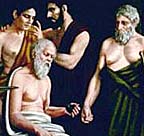 "The first medieval reference to anaesthesia was in the fourth century, in the writings of Hilary of Poitiers. Hilary was Bishop of Poitiers, exiled to the Orient in 356 A. D. by the Emperor Constantius. It was in the Orient that he first wrote about anaesthesia. He described drugs that lulled the soul to sleep. In 359 A. D Hilary returned to Poitiers. Apuleius, a compiler of medical literature in the fifth century wrote '...if anyone is to have a limb mutilated, burnt, or sawn, he may drink a half ounce with wine, and whilst he sleeps the member may be cut off without any pain or sense."
"The first medieval reference to anaesthesia was in the fourth century, in the writings of Hilary of Poitiers. Hilary was Bishop of Poitiers, exiled to the Orient in 356 A. D. by the Emperor Constantius. It was in the Orient that he first wrote about anaesthesia. He described drugs that lulled the soul to sleep. In 359 A. D Hilary returned to Poitiers. Apuleius, a compiler of medical literature in the fifth century wrote '...if anyone is to have a limb mutilated, burnt, or sawn, he may drink a half ounce with wine, and whilst he sleeps the member may be cut off without any pain or sense."
I also did not realize that hemlock was used in ancient times as an anesthetic (as well as a poison). However, this article pointed out the problems the ancients had with trying to regulate the dose and the sometimes dire consequences.
"Hemlock caused as many problems as it relieved. This is because the level of hemlock contained in leaves varied according to weather, climate, the age of harvesting of the plant, the conditions in which it was grown etc., and so the quantity of hemlock that was used in potions was not constant. This led to accidental overdoses and death."
Monday, December 15, 2003
Rediscovering Homer: Poetry and Performance
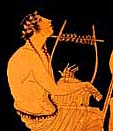 "Admired through the ages as the ultimate epic, Homer's Iliad, along with its companion-piece, the Odyssey, was venerated by the ancient Greeks themselves as the cornerstone of their civilization. By force of its prestige, the Iliad sets the standard for the definition of the word epic: an expansive poem of enormous scope, composed in an archaic and superbly elevated style of language, concerning the wondrous deeds of heroes."
"Admired through the ages as the ultimate epic, Homer's Iliad, along with its companion-piece, the Odyssey, was venerated by the ancient Greeks themselves as the cornerstone of their civilization. By force of its prestige, the Iliad sets the standard for the definition of the word epic: an expansive poem of enormous scope, composed in an archaic and superbly elevated style of language, concerning the wondrous deeds of heroes."
Thursday, December 11, 2003
Belisarius' Bid for Rome
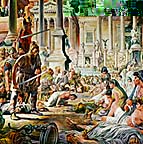 "On December 9, 536 AD, Byzantine Count Belisarius entered Rome through the Asinarian Gate at the head of 5,000 troops. At the same time, 4,000 Ostrogoths left the city through the Flaminian Gate and headed north to Ravenna, the capital of their Italian kingdom. For the first time since 476, when the Germanic king, Odoacer, had deposed the last Western Roman emperor and crowned himself 'King of the Romans,' the city of Rome was once more part of the Roman empire--albeit an empire whose capital had shifted east to Constantinople."
"On December 9, 536 AD, Byzantine Count Belisarius entered Rome through the Asinarian Gate at the head of 5,000 troops. At the same time, 4,000 Ostrogoths left the city through the Flaminian Gate and headed north to Ravenna, the capital of their Italian kingdom. For the first time since 476, when the Germanic king, Odoacer, had deposed the last Western Roman emperor and crowned himself 'King of the Romans,' the city of Rome was once more part of the Roman empire--albeit an empire whose capital had shifted east to Constantinople."
"Centuries of warfare against mounted enemies such as the Goths, Huns and Persians, however, had changed the makeup of the Roman army. By the 6th century ad, the army consisted primarily of a cavalry force of armored lancers, or cabalarii, wearing body armor and capable of handling a bow from horseback. Garrison duties and defensive positions were held by two types of infantry: lightly armed archers and heavily armed soldiers in mail jackets who fought with sword, ax and spear."
"For Belisarius' small army, the struggle for Rome required tactics that involved horsemen striking swiftly from walled cities much as the knights of a later age would do. The campaign would amount to a series of sieges against and sorties from fortified places rather than being fought in the field as early Roman wars had been."
"Nubia: The Forgotten Kingdom" Resists Rome
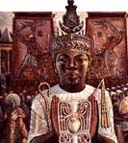 Last night I watched an interesting program on the Discovery Channel, “Nubia, The Forgotten Kingdom”, and learned that the Romans were defeated in battle by the Nubians led by a powerful Queen in 23 B.C. during the reign of Augustus. I was totally unfamiliar with this episode of Roman conflict. I did a little research and found this interesting reference:
Last night I watched an interesting program on the Discovery Channel, “Nubia, The Forgotten Kingdom”, and learned that the Romans were defeated in battle by the Nubians led by a powerful Queen in 23 B.C. during the reign of Augustus. I was totally unfamiliar with this episode of Roman conflict. I did a little research and found this interesting reference:
http://www.freemaninstitute.com/Gallery/nubia.htm
stating:
“Rome gained control of Egypt and all of the north African coastline and exacted tribute from Kush. Kush, called "Aethiopia" by the Romans (not to be confused with the present Ethiopia which was called Abyssinia by the Romans - see Axum), seeing Rome edge into lower Nubia, attacked and sacked the Roman outposts at Elephantine and Syene. the Romans retaliated and conquered the Kushite towns of Dakka and Premnis. Then Rome marched on Napata where the queen was in residence. She sued for peace and was refused. Rome then attacked Napata and razed it to the ground, making slaves of their captives. After that Rome fortified Premnis and kept it as their southernmost border while waging a three year war with Kush.”
”Finally, the Kandake marched upon Premnis and sued for peace, appealing to August Caesar. Impressed with the Kandake's appeal, and probably being aware that Rome had overextended itself at so distant a border, He accepted at about 20 BC. Kush was freed from further tribute, the borders were established at their Ptolemaic location, and Premnis was returned to Kushite control.”
I found more information at: http://www.internetpuppets.org/afrnubia.html
“Rome sent a legion, under the command of General Petronius (24 B.C. - 21 B.C.), to subdue Nubia and seize control of the gold trade. The Nubian army, led by Queen Amanirenas, smashed the Roman forces at Aswan, Philae, and Elephantine. The African army had stood against the most powerful state in the ancient world - Imperial Rome. This was Africa's finest hour. The Roman military had been stalemated and Nubia was divided into Lower Nubia (Roman) and Upper Nubia (Meroitic).”
”Meroitic history is filled with powerful Queen mothers. Women ruled with the same authority as men. The Meroitic alphabet has never been deciphered due to the lack of a translation key or Rosetta stone. The Nubians so disliked their Roman neighbors that a bust of Caesar Augustus was buried beneath a doorway to a temple.”
Strabo’s account of the action seems to downplay the Nubian’s successes:
Egypt was from the first disposed to peace, from having resources within itself, and because it was difficult of access to strangers. It was also protected on the north by a harborless coast and the Egyptian Sea; on the east and west by the desert mountains of Libya and Arabia, as I have said before. The remaining parts towards the south are occupied by Troglodytae, Blemmyae, Nubiae, and Megabarae Ethiopians above Syene. These are nomads, and not numerous nor warlike, but accounted so by the ancients, because frequently, like robbers, they attacked defenseless persons. Neither are the Ethiopians, who extend towards the south and Meroë, numerous nor collected in a body; for they inhabit a long, narrow, and winding tract of land on the riverside, such as we have before described; nor are they well prepared either for war or the pursuit of any other mode of life.
At present the whole country is in the same pacific state, proof of which is that the upper country is sufficiently guarded by three cohorts, and these not complete. Whenever the Ethiopians have ventured to attack them, it has been at the risk of danger to their own country. The rest of the forces in Egypt are neither very numerous, nor did the Romans ever once employ them collected into one army. For neither are the Egyptians themselves of a warlike disposition, nor the surrounding nations, although their numbers are very large.
Cornelius Gallus, the first governor of the country appointed by Augustus Caesar, attacked the city Hero?polis, which had revolted [in 28 B.C.], and took it with a small body of men. He suppressed also in a short time an insurrection in the Thebaïs which originated as to the payment of tribute. At a later period Petronius resisted, with the soldiers about his person, a mob of myriads of Alexandrines, who attacked him by throwing stones. He killed some, and compelled the rest to desist.
We have before related how Aelius Gallus, when he invaded Arabia with a part of the army stationed in Egypt, exhibited a proof of the unwarlike disposition of the people; and if Syllaeus had not betrayed him, he would have conquered the whole of Arabia Felix. The Ethiopians, emboldened in consequence of a part of the forces in Egypt being drawn off by Aelius Gallus, who engaged in war with the Arabs, invaded the Thebaïs and attacked the garrison, consisting of three cohorts, near Syene; surprised and took Syene, Elephantine, and Philae, a sudden inroad; enslaved the inhabitants, and threw down statues of Caesar. But Petronius, marching with less than 10,000 infantry and 800 horse against an army of 30,000 men, compelled them to retreat to Pselchis [former Maharraqa--now submerged beneath Lake Nasser], an Ethiopian city. He then sent deputies to demand restitution of what they had taken, and the reasons which had induced them to begin the war.
On their alleging that they had been ill-treated by the nomarchs, he answered, that these were not the sovereign of the country, but Caesar. When they desired three days for consideration, and did nothing which they were bound to do, Petronius attacked and compelled them to fight. They soon fled, being badly commanded, and badly armed; for they carried large shields made of raw hides, and hatchets for defensive weapons; some, however, had pikes, and others swords. Part of the insurgents were driven into the city, others fled into the uninhabited country; and such as ventured upon the passage of the river escaped to a neighboring island, where there were not many crocodiles on account of the current. Among the fugitives were the generals of the Candace, queen of the Ethiopians in our time, a masculine woman, and who had lost an eye. Petronius, pursuing them in rafts and ships, took them all and despatched them immediately to Alexandria. He then attacked Pselchis and took it. If we add the number of those who fell in battle to the number of prisoners, few only could have escaped.
From Pselchis Petronius went to Premnis [the former Karanog--now also submerged beneath Lake Nasser], a strong city, traveling over the hills of sand, beneath which the army of Cambyses [king of Persia, and successor to Cyrus the Great] was overwhelmed by the setting in of a whirlwind. He took the fortress at the first onset, and afterwards advanced to Napata. This was the royal seat of the Candace; and her son was there, but she herself was in a neighboring stronghold. When she sent ambassadors to treat of peace, and to offer the restitution of the prisoners brought from Syene, and the statues, Petronius attacked and took Napata, from which her son had fled, and then razed it. He made prisoners of the inhabitants, and returned back again with the booty, as he judged any farther advance into the country impracticable on account of the roads. He strengthened, however, the fortifications of Premnis, and having placed a garrison there, with two years' provisions for four hundred men, returned to Alexandria. Some of the prisoners were publicly sold as loot, and a thousand were sent to Caesar, who had lately returned from the Cantabrians, others died of various diseases.
In the meantime the Candace attacked the garrison with an army of many thousand men. Petronius came to its assistance, and entering the fortress before the approach of the enemy, secured the place by many expedients. The enemy sent ambassadors, but he ordered them to repair to Caesar: in their replying, that they did not know who Caesar was, nor where they were to find him, Petronius appointed persons to conduct them to his presence. They arrived at Samos, where Caesar was at that time, and from whence he was on the point of proceeding into Syria, having already despatched Tiberius into Armenia. The ambassadors obtained all that they desired, and Caesar even remitted the tribute which he had imposed. . .
Treasures of Tuscany New Exhibit Slated for Edinburgh
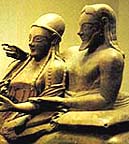 "A wealth of treasures collected from Etruscan tombs will go on display at the Royal Museum in Edinburgh beginning in July 2004. The three month exhibit will include fine ceramics, life-sized sarcophagi and objects from temples and sanctuaries such as architectural reliefs and bronze figurines.
"A wealth of treasures collected from Etruscan tombs will go on display at the Royal Museum in Edinburgh beginning in July 2004. The three month exhibit will include fine ceramics, life-sized sarcophagi and objects from temples and sanctuaries such as architectural reliefs and bronze figurines.
The Etruscans heavily influenced the Romans, and therefore modern-day Italy.
The origins of the Etruscan civilisation, which lasted for about 900 years, are not clear. In Italy, they developed what is believed to have been a refined culture and sophisticated agriculture, but their history was long shrouded in mystery because little was known about their language.
The Etruscans, who are credited with building Western Europe’s first cities, occupied lands in an area between present-day Florence and Rome, bordered by the Arno and Tiber rivers, in the regions known today as Umbria and Tuscany, as well as northern Lazio all the way to Rome. "
Monday, December 08, 2003
Size Does Matter - At Least During the Reign of Elagabalus
"The emperor Elagabalus appointed ministers in Rome through a competitive appraisal that Edward Gibbon, the 18th century historian of the Roman empire, described delicately as one based on 'enormitate membrorum.' "
According to Mad Monarchs:
"Originally Elagabalus was called Varius Avitus Bassianus. He became known as Elagabalus, because he was the high priest of the deity El-Gabal, possibly the Syrian sun god Baal. It was a phallic-oriented cult; the sun god was worshipped in the form of a great, black meteorite and two colossal phalli flanked the entrance of the temple in Emesa. When Elagabalus became Emperor, he attempted to introduce this Syrian cult to Rome. He had a new temple built on Rome's Palatine Hill and had El-Gabal's black relic transported to the new temple in a chariot decorated with gold and precious stones.
Elagabalus created a public bath inside the palace, so that he could collect paramours with remarkable phallic endowments. Even more infuriating to the people of Rome was the appointment of his lowborn lovers to the highest offices.
According to Mad Monarchs:
"Originally Elagabalus was called Varius Avitus Bassianus. He became known as Elagabalus, because he was the high priest of the deity El-Gabal, possibly the Syrian sun god Baal. It was a phallic-oriented cult; the sun god was worshipped in the form of a great, black meteorite and two colossal phalli flanked the entrance of the temple in Emesa. When Elagabalus became Emperor, he attempted to introduce this Syrian cult to Rome. He had a new temple built on Rome's Palatine Hill and had El-Gabal's black relic transported to the new temple in a chariot decorated with gold and precious stones.
Elagabalus created a public bath inside the palace, so that he could collect paramours with remarkable phallic endowments. Even more infuriating to the people of Rome was the appointment of his lowborn lovers to the highest offices.
Thursday, December 04, 2003
Imperatores Victi
By Nathan Rosenstein
"The glory and wealth that the city's conquerors gained by their victories paved the way to office, authority, and enhanced prestige when they returned to civilian life. But did that connection obtain in the other direction as well? Was military failure likely to bring serious political damage in its train? Athens in the fifth and fourth centuries seems to offer an obvious analogy. Then, too, successful war leaders enjoyed great influence in the political arena, but those whose operations failed regularly paid a heavy price. Thucydides is the best known but by no means the only politician to have had a career cut short by the domestic fallout from a military defeat. Prosecutions on charges brought by eisangelia were a constant danger to strategoi after battles were lost or when foreign-policy initiatives went awry. At Carthage the consequences could be even more frightening. The citizens there evinced a singular brutality when their armies met defeat: Punic commanders were crucified.
Common sense might suggest that punitive measures would have been equally prevalent at Rome. Military failure affected the citizens directly. The soldiers who filled the legions and suffered most when battles were lost voted in the assemblies, if they returned alive. And whether they did or not, their suffering touched relatives and friends, among whom the men also had votes. Even Romans with no personal ties to those in the ranks could be moved by anger and fear when defeat damaged the prestige of their city or imperiled its safety, and a hostile populace at Rome had effective ways of lashing out. The bulk of aristocratic competition took place under its arbitration, in elections for office or through the deliberations of judicial assemblies. Hatred and a desire for vengeance against the commander responsible therefore ought to have made themselves felt at the polls, ending his chances for further honors and perhaps even being visited on his descendants. Even greater danger could come from the courts. A military defeat might furnish grounds for a capital charge, and all such cases, until late in the history of the Republic, came before the voters in the comitiacenturiata for trial. To be effective, of course, public animosity needed leaders to marshal and focus it, but candidates would not have been lacking. Working up popular rage and exploiting it for political advantage or to humiliate a rival was commonplace among ambitious aristocrats. Men eager for office ought not to have let the electorate forget an opponent's earlier failures. Enemies should have been quick to bring a rival to trial when he had led Roman soldiers to defeat."
"The glory and wealth that the city's conquerors gained by their victories paved the way to office, authority, and enhanced prestige when they returned to civilian life. But did that connection obtain in the other direction as well? Was military failure likely to bring serious political damage in its train? Athens in the fifth and fourth centuries seems to offer an obvious analogy. Then, too, successful war leaders enjoyed great influence in the political arena, but those whose operations failed regularly paid a heavy price. Thucydides is the best known but by no means the only politician to have had a career cut short by the domestic fallout from a military defeat. Prosecutions on charges brought by eisangelia were a constant danger to strategoi after battles were lost or when foreign-policy initiatives went awry. At Carthage the consequences could be even more frightening. The citizens there evinced a singular brutality when their armies met defeat: Punic commanders were crucified.
Common sense might suggest that punitive measures would have been equally prevalent at Rome. Military failure affected the citizens directly. The soldiers who filled the legions and suffered most when battles were lost voted in the assemblies, if they returned alive. And whether they did or not, their suffering touched relatives and friends, among whom the men also had votes. Even Romans with no personal ties to those in the ranks could be moved by anger and fear when defeat damaged the prestige of their city or imperiled its safety, and a hostile populace at Rome had effective ways of lashing out. The bulk of aristocratic competition took place under its arbitration, in elections for office or through the deliberations of judicial assemblies. Hatred and a desire for vengeance against the commander responsible therefore ought to have made themselves felt at the polls, ending his chances for further honors and perhaps even being visited on his descendants. Even greater danger could come from the courts. A military defeat might furnish grounds for a capital charge, and all such cases, until late in the history of the Republic, came before the voters in the comitiacenturiata for trial. To be effective, of course, public animosity needed leaders to marshal and focus it, but candidates would not have been lacking. Working up popular rage and exploiting it for political advantage or to humiliate a rival was commonplace among ambitious aristocrats. Men eager for office ought not to have let the electorate forget an opponent's earlier failures. Enemies should have been quick to bring a rival to trial when he had led Roman soldiers to defeat."
Spectacle and Society in Livy’s History
"Livy's use of “spectacular” effects has traditionally been attributed to a desire to stimulate the emotions of his audience. Far from enhancing the credibility of his narrative, elaborate set pieces like the account of the fall of Alba Longa or of the scene in Rome following the announcement of Hannibal’s victory at Lake Trasimene, in which Livy combines an attention to the precise sensory components of the scene, such as the dust cloud rising over Alba, with a description of the extreme emotions of those actually present, have suggested that Livy’s was drawn away from his historiographical duties by “allure of dramatic techniques.”
"There is yet another dimension to enargeia’s capacity to make the past present. Within this passage, describing the profectio or ritual departure of the consul P. Licinius Crassus from Rome at the start of his campaign against Perseus of Macedon in 171 B.C.E., the process of vision plays a very precise role in communicating the social and political authority of the consul to the spectators and thus reinforcing the bond that links them to the collective power of the state:
It happened that during those days the consul P. Licinius, after offering vows on the Capitoline, set forth from the city in the costume of a general. This event is always [conducted] with great dignity and majesty, but it especially attracts eyes and minds when they follow a consul setting forth against a great enemy distinguished by his prowess or his fortune. For not only the performance of duty draws the crowd but also their enthusiasm for the spectacle, that they might see their leader, to whose power [imperium] and planning [consilium] they have entrusted the protection of the Republic itself. Then there enters their minds the reckoning of the contingencies of war, how uncertain is the outcome of fortune, and how impartial is Mars, what disasters have come about through the ignorance and rashness of the leaders, and yet what advantages have been the result of foresight and valor. What man knew which was the intellect and which the fortune of the consul they were sending to war? Would they soon see him in his triumph, ascending the Capitolium with his victorious troops to the same gods from whom he was setting out, or would they offer this pleasure to their enemies?
This digital version of Andrew Feldherr's work is part of the new eScholarship database of the University of California Press.
"There is yet another dimension to enargeia’s capacity to make the past present. Within this passage, describing the profectio or ritual departure of the consul P. Licinius Crassus from Rome at the start of his campaign against Perseus of Macedon in 171 B.C.E., the process of vision plays a very precise role in communicating the social and political authority of the consul to the spectators and thus reinforcing the bond that links them to the collective power of the state:
It happened that during those days the consul P. Licinius, after offering vows on the Capitoline, set forth from the city in the costume of a general. This event is always [conducted] with great dignity and majesty, but it especially attracts eyes and minds when they follow a consul setting forth against a great enemy distinguished by his prowess or his fortune. For not only the performance of duty draws the crowd but also their enthusiasm for the spectacle, that they might see their leader, to whose power [imperium] and planning [consilium] they have entrusted the protection of the Republic itself. Then there enters their minds the reckoning of the contingencies of war, how uncertain is the outcome of fortune, and how impartial is Mars, what disasters have come about through the ignorance and rashness of the leaders, and yet what advantages have been the result of foresight and valor. What man knew which was the intellect and which the fortune of the consul they were sending to war? Would they soon see him in his triumph, ascending the Capitolium with his victorious troops to the same gods from whom he was setting out, or would they offer this pleasure to their enemies?
This digital version of Andrew Feldherr's work is part of the new eScholarship database of the University of California Press.
Tuesday, December 02, 2003
Roman Law Resources
An excellent site on Roman Law created and maintained by Ernest Metzger, University of Aberdeen.
"This site provides information on Roman law sources and literature, the teaching of Roman law, and the persons who engage in the study of Roman law. "
"This site provides information on Roman law sources and literature, the teaching of Roman law, and the persons who engage in the study of Roman law. "
Wednesday, November 26, 2003
Jason and search for the truth
 We have been having a lively discussion about historic truth on our Imperial Rome discussion group. I noticed that the program "The Real Jason and the Argonauts" was going to air again this weekend and found this article about the project interesting - especially the director's philosophical sensitivity about historical truth.
We have been having a lively discussion about historic truth on our Imperial Rome discussion group. I noticed that the program "The Real Jason and the Argonauts" was going to air again this weekend and found this article about the project interesting - especially the director's philosophical sensitivity about historical truth.
"'You have to be careful dealing with myths because they have a lot to do often with people's sense of self and national identities, and there's no need to shatter things like that.
'What I'm looking at complements rather than undermines. It's just a different way of understanding these stories in different ages, I think.
'These days, the modern inquiring mind requires that we find out who the real people are, but it doesn't mean those myths are any less true for the people of other ages.
'There's a fine balance between literal truth and artistic truth, and often we learn more about ourselves from artistic truth than literal truth."
I was also interested to note that the article pointed out that even the Romans were convinced of the historical nature of the story and attempted to find evidence of the real Jason in ancient Georgia.
Monday, November 17, 2003
Kate Devlin Illuminates the Archaeological Record
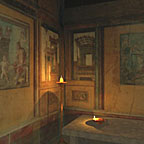 Kate Devlin, a researcher specializing in the computer reconstruction of archaeological sites explains her unique approach that incorporates realistic ancient lighting with archaeological perspective, "The ways in which we view, perceive and understand objects is governed by our current lighting methods of steady, bright electric light or large windows, but in order to understand how an environment and its contents were viewed in the past we must consider how they were illuminated. Light cannot be captured in the archaeological record and consequently its importance is rarely considered in interpretations of past environments. Experimental archaeology and realistic lighting simulation allow us to recreate the original lighting of an archaeological site or artefact and show it how it might have looked to those who built and used it. "
Kate Devlin, a researcher specializing in the computer reconstruction of archaeological sites explains her unique approach that incorporates realistic ancient lighting with archaeological perspective, "The ways in which we view, perceive and understand objects is governed by our current lighting methods of steady, bright electric light or large windows, but in order to understand how an environment and its contents were viewed in the past we must consider how they were illuminated. Light cannot be captured in the archaeological record and consequently its importance is rarely considered in interpretations of past environments. Experimental archaeology and realistic lighting simulation allow us to recreate the original lighting of an archaeological site or artefact and show it how it might have looked to those who built and used it. "
Wednesday, November 12, 2003
Bravehearts: Men in Skirts
"Bravehearts: Men in Skirts", a new exhibit at the Metropolitan Museum of Art, locates “men in skirts” in historical and cross-cultural contexts and looks at designers as well as individuals who have appropriated the skirt as a means of injecting novelty into male fashion, transgressing moral and social codes, and redefining ideals of masculinity. "
This exhibit reminds me of a website I stumbled across for a Roman reenactors group at Fort Bragg, North Carolina. Their main page proudly proclaimed "Real men don't wear pants!" I initially read about this exhibit in an article by Barbara Nachman in The Journal News. However, Barbara committed a major faux pax in her remark "Consider the ancient Greeks and Romans, who fought in togas; the Scottish warriors who battled in kilts; the fierce Masai from Kenya, who wore a length of cloth wrapped around their bodies and tied over one shoulder. " I sent her an email to explain that togas were ceremonial garments and were not worn in battle. I suggested she review http://julilla.tripod.com/toga.htm
This exhibit reminds me of a website I stumbled across for a Roman reenactors group at Fort Bragg, North Carolina. Their main page proudly proclaimed "Real men don't wear pants!" I initially read about this exhibit in an article by Barbara Nachman in The Journal News. However, Barbara committed a major faux pax in her remark "Consider the ancient Greeks and Romans, who fought in togas; the Scottish warriors who battled in kilts; the fierce Masai from Kenya, who wore a length of cloth wrapped around their bodies and tied over one shoulder. " I sent her an email to explain that togas were ceremonial garments and were not worn in battle. I suggested she review http://julilla.tripod.com/toga.htm
Tuesday, November 04, 2003
HBO and BBC to coproduce "Rome"
How exciting!
The BBC and premium movie channel HBO will co-produce an epic and sweeping new drama series Rome, chronicling the rise of the ancient Roman empire through the eyes of two foot-soldiers. The first series of 12 episodes is planned to be broadcast on BBC Two and on HBO in 2005. Rome is an intimate drama of love and betrayal, masters and slaves, and husbands and wives. It chronicles epic times that saw the fall of a republic and the creation of an empire.
The series begins in 51 BC, as Gaius Julius Caesar has completed his masterful conquest of Gaul after eight years of war, and is preparing to return to Rome. He heads home with thousands of battle-hardened men and a populist agenda for radical social change. Terrified, the aristocracy threatens to prosecute Caesar for war crimes as soon as he sets foot in Rome.
Caesar's old friend and mentor, Pompey Magnus attempts to foment mutiny in order to maintain the balance of power. Two of Caesar's soldiers, Lucius Vorenus and Titus Pullo, thwart Pompey's plan. Their fates become entwined with those of Caesar, Mark Antony, Cleopatra, and the boy Octavian, a strange and awkward child. By political guile and bloody force, he will become Rome's first Emperor.
BBC Two controller Jane Root adds, "Rome is a unique drama series that allows us to look at the birth of the Roman Empire through the eyes of ordinary citizens as well as famous historical figures such as Julius Caesar, Mark Antony and Octavian. It is an intimate portrayal of a fascinating and influential period of history - the birth of a modern society as we know it today. It brings us vividly into everyday Roman life."
The BBC and premium movie channel HBO will co-produce an epic and sweeping new drama series Rome, chronicling the rise of the ancient Roman empire through the eyes of two foot-soldiers. The first series of 12 episodes is planned to be broadcast on BBC Two and on HBO in 2005. Rome is an intimate drama of love and betrayal, masters and slaves, and husbands and wives. It chronicles epic times that saw the fall of a republic and the creation of an empire.
The series begins in 51 BC, as Gaius Julius Caesar has completed his masterful conquest of Gaul after eight years of war, and is preparing to return to Rome. He heads home with thousands of battle-hardened men and a populist agenda for radical social change. Terrified, the aristocracy threatens to prosecute Caesar for war crimes as soon as he sets foot in Rome.
Caesar's old friend and mentor, Pompey Magnus attempts to foment mutiny in order to maintain the balance of power. Two of Caesar's soldiers, Lucius Vorenus and Titus Pullo, thwart Pompey's plan. Their fates become entwined with those of Caesar, Mark Antony, Cleopatra, and the boy Octavian, a strange and awkward child. By political guile and bloody force, he will become Rome's first Emperor.
BBC Two controller Jane Root adds, "Rome is a unique drama series that allows us to look at the birth of the Roman Empire through the eyes of ordinary citizens as well as famous historical figures such as Julius Caesar, Mark Antony and Octavian. It is an intimate portrayal of a fascinating and influential period of history - the birth of a modern society as we know it today. It brings us vividly into everyday Roman life."
Thursday, October 30, 2003
Roman adoption of Celtic Samhain ritual evolves into Halloween
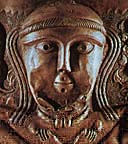 "Many of the ancient peoples of Europe marked the end of the harvest season and the beginning of winter by celebrating a holiday in late autumn. The most important of these holidays to influence later Halloween customs was Samhain, a holiday observed by the ancient Celts. Among the Celts, Samhain marked the end of one year and the beginning of the next.
"Many of the ancient peoples of Europe marked the end of the harvest season and the beginning of winter by celebrating a holiday in late autumn. The most important of these holidays to influence later Halloween customs was Samhain, a holiday observed by the ancient Celts. Among the Celts, Samhain marked the end of one year and the beginning of the next.
Samhain began at sundown on October 31 and extended into the following day. According to the Celtic pagan religion, known as Druidism, the spirits of those who had died in the preceding year roamed the earth on Samhain. The Celts sought to ward off these spirits with offerings of food and drink. The Celts also built bonfires and performed rituals, often involving sacrifices.
By the end of the 1st century AD, the Roman Empire had conquered most of the Celtic lands. In the process of incorporating the Celts into their empire, the Romans adapted and absorbed some of their traditions as part of their own pagan and Catholic religious observances.
Celtic influences lingered a long time in the western fringes of Europe and Samhain was abandoned only when the local people converted to Christianity during the early Middle Ages. The Roman Catholic Church often incorporated modified versions of older religious traditions in order to win converts. An example is when Pope Gregory IV sought to replace Samhain with All Saints’ Day in 835. All Souls’ Day, closer in spirit to Samhain and modern Halloween, was first instituted at a French monastery in 998 and spread quickly across Europe. Folk observances linked to these Christian holidays, including Halloween, thus preserved many ancient Celtic customs associated with Samhain."
See article.
Monday, October 27, 2003
Pliny's Description of Mummification Proved Accurate
"Modern science has finally found the secret of why some mummies can last for thousands of years," Ulrich Weser of the University of Tübingen told Reuters Wednesday. Chemists from the University of Tübingen and the Munich-based Doerner-Institut replicated an ancient treatment of cedar wood and found it contained a preservative chemical called guaiacol.
The team extracted the cedar oil using a method mentioned in a work by Pliny the Elder, a Roman encyclopedist who wrote of an embalming ointment called “cedrium.” Although there are no contemporary descriptions of how the tar was made, modern Egyptologists had overlooked Pliny’s account, as he was writing centuries later.
Weser said that, despite ancient mentions of “cedar-juice,” scholars believed juniper to be the source because of similar Greek names and some mummies being found clutching juniper berries. But, tests of juniper extracts found they did not contain the guaiacol preservatives.
The team extracted the cedar oil using a method mentioned in a work by Pliny the Elder, a Roman encyclopedist who wrote of an embalming ointment called “cedrium.” Although there are no contemporary descriptions of how the tar was made, modern Egyptologists had overlooked Pliny’s account, as he was writing centuries later.
Weser said that, despite ancient mentions of “cedar-juice,” scholars believed juniper to be the source because of similar Greek names and some mummies being found clutching juniper berries. But, tests of juniper extracts found they did not contain the guaiacol preservatives.
Tuesday, October 21, 2003
Roman Arthur portrayed in Disney's King Arthur Set for 2004 Release
 Clive Owen will be seen as King Arthur in Disney's big-budget adaptation from director Antoine Fuqua and producer Jerry Bruckheimer.
Clive Owen will be seen as King Arthur in Disney's big-budget adaptation from director Antoine Fuqua and producer Jerry Bruckheimer.
"'I play Arthur, who is half-Roman,' Owen says. 'He's a commander of a crack team of military knights who, at the beginning of the movie, gets the mission from hell -- to go into dangerous, unknown territory and rescue a family as the Saxons are invading by the thousands, and the rebels are out there fighting. Meanwhile, Arthur has always held onto Rome as something he wants to return to and something he reveres, but it keeps changing.'"
Monday, October 20, 2003
Imag(in)ing Livia and Cleopatra in Augustan Rome
 by Mary McHUGH
by Mary McHUGH
"Whether or not she actually possessed the positive qualities for which she is credited in Julio-Claudian art and propaganda, in the Roman imagination the images of Livia, the wife of Augustus, stand in marked contrast to those of Cleopatra VII, the last Ptolemaic ruler of Egypt. Livia exemplifies traditional matronly virtue and marital respectability, whereas Cleopatra exemplifies the excesses of extravagance, drunkenness, and sexual impropriety. And yet, the visual language employed in the praise of Livia at Rome is nearly identical to that used by Cleopatra in her own propaganda in Egypt. This paper is a study in how the praise of Livia and the vilification of Cleopatra in Augustan propaganda emerged from the same source, conditioned by their unique socio-historical contexts."
Mary McHugh's paper in its entirety will be presented at the 2004 Joint Annual Meeting of the Archaeological Institute of America and the American Philological Association to be held Friday, January 2, 2004 - Monday, January 5, 2004 at the San Francisco Hilton.
Diviciacus' Tears: the Portrayal of the Aedui in Caesar's Bellum Gallicum
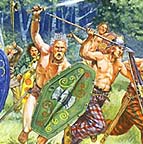 By Alexa Jervis
By Alexa Jervis
"In the Bellum Gallicum, Caesar's loyalty to the Aedui appears unbounded, as does his admiration for one of their leading men, Diviciacus. Caesar justifies his determination to take military action by invoking the Aedui and Caesar's portrait of Diviciacus has recently been cited as evidence of the author's tendency to burnish the reputations of Gauls loyal to Rome. But Diviciacus and his fellow tribesmen display one trait, often ignored by scholars, that suggests Caesar's portrayal of them may not be entirely positive in their propensity to weep."
"Romans cry at their lowest, most unroman moments during the panic that precedes their encounter with Ariovistus, and shortly before Ambiorix's fatal attack on Sabinus and Cotta's men...The frequent appearance of Aeduan tears signals a feeble nature, and subtly undercuts Caesar's apparent esteem."
Alexa Jervis' paper in its entirety will be presented at the 2004 Joint Annual Meeting of the Archaeological Institute of America and the American Philological Association to be held Friday, January 2, 2004 - Monday, January 5, 2004 at the San Francisco Hilton.
Gladiator at the Millenium
 by Emily Albu
by Emily Albu
"In films as disparate as Roman Scandals (1933) and The Sign of the Cross (1932), Rome typically stands as a mirror to American foibles, fears, and aspirations. We are so used to the analogy that we do not blink when Roman history shifts cataclysmically to accommodate our metaphor. So for instance, Gladiator has noble democrats in the senate and army ally with an imperial daughter to restore the republic - defying history to fulfill democratic wishes dearly held by viewers. This paper explores the ways that Gladiator satisfied these and other longings of the US electorate, during the 2000 presidential campaign, for a decent leader uncorrupted by politics, a Cincinnatus ambitious only for his home, wife, and son. "
Emily Albu's paper in its entirety will be presented at the 2004 Joint Annual Meeting of the Archaeological Institute of America and the American Philological Association to be held Friday, January 2, 2004 - Monday, January 5, 2004 at the San Francisco Hilton.
Wednesday, October 15, 2003
Zeugma Featured On Nova
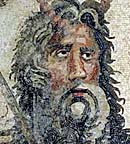 Last night I watched another program on the last-minute excavations at Zeugma. I had seen one earlier but I think this one was different. Of course, I love beautiful mosaics and the mosaics uncovered at Zeugma were some of the most beautiful I have ever seen. In fact, when it showed a computer recreation of the triclinium, I wondered how anyone could concentrate on their meal with such a breathtaking colorful mosaic on the floor.
Last night I watched another program on the last-minute excavations at Zeugma. I had seen one earlier but I think this one was different. Of course, I love beautiful mosaics and the mosaics uncovered at Zeugma were some of the most beautiful I have ever seen. In fact, when it showed a computer recreation of the triclinium, I wondered how anyone could concentrate on their meal with such a breathtaking colorful mosaic on the floor.
"Forty-five kilometers away from Gaziantep close to the town of Nizip on the Euphrates is the tiny village of Belkis, whose inhabitants carefully tender their groves of pistachio trees. The nuts are their sole source of income. Yet not all wealth can be measured in currency, and the villagsed real asset is the magnificent ruins of the ancient city of Zeugma, which has stayed buried beneath the pistachio groves for nearly two thousand years.Belkis/Zeugma is considered among the four most important settlement areas under the reign of the Kingdom of Commanage.
In the Hellenistic Era the city was called “Seleukeia of Euphrates”. The ancient city of Zeugma, originally, was founded by Selevkos Nikador, one of the generals of the Alexander the Great, in 300 B.C. At that time the city was named after the general and called “ Selevkaya Euphrates.” And the population in the city was approximately 80 000. In 64 B.C. Zeugma was conquered and ruled by Roman Empire and with this shift the name of the city was changed into Zeugma to mean “bridge-passage.”
During the roman rule, the city became one of the attractions in the region, due to its commercial potential originating from geostrategic location. Because, the Zeugma city was on the silkroad connecting Antiach to China with a quay on the river Euphrates. In 256 A.D." - Dr. M. Semih SUMMAK (P.hD)
See also: http://www.zeugmaweb.com/zeugma/english/engindex.htm
Tuesday, October 14, 2003
Boudicca's Last Battle
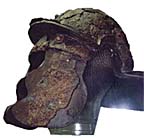 "Suetonius chose a position in a defile, with a wood behind him," explains military historian Martin Marix Evans. "There could be no enemy, he knew, except at his front, where there was open country without cover for ambushes."
"Suetonius chose a position in a defile, with a wood behind him," explains military historian Martin Marix Evans. "There could be no enemy, he knew, except at his front, where there was open country without cover for ambushes."
With archaeological estimates for a British population now at upwards of five million in Boudica's time - a figure not reached again until the 17th century - it is possible she had well over 100,000, not an army but a whole people bent on revenge.
"Grandparents, children, carts, cows," said Marix Evans. He estimates that Suetonius had something like 10,000, all regular soldiers.
"So, just as at Agincourt, he has to get the enormous enemy into a funnel. And here, beside this stream, under what would then have been a wooded hill, he has it, his army backed like a hermit crab in its shell. One and a half legions, men standing six feet apart to throw their javelins, a front of getting on for half a mile, auxiliary troops and cavalry on the slopes."
The two javelins thrown, which would have checked the British charge, the shields come down and the short swords begin stabbing.
Monday, October 13, 2003
Scotsman Gives BBC's Colosseum: Arena of Death Thumbs Up
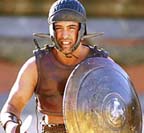 "The really sexy new history shows have been entrusted to the BBC’s Special Projects, and the BBC’s two most prestigious productions for the autumn are not drama series, nor comedies, but proud examples of their new toy: 'drama reconstruction'. It’s a genre they pioneered last year with a somewhat enervating portrayal of the construction of the Great Pyramid. If the computer graphics, sets and location filming were all groundbreaking, Pyramid was let down by concerning itself with, well, groundbreaking. Try as you might, it is difficult to make a building site exciting, even if these were the foundations for one of the wonders of the ancient world. The stilted and witless 'dramatisation' also stopped well short of arresting the attention. "
"The really sexy new history shows have been entrusted to the BBC’s Special Projects, and the BBC’s two most prestigious productions for the autumn are not drama series, nor comedies, but proud examples of their new toy: 'drama reconstruction'. It’s a genre they pioneered last year with a somewhat enervating portrayal of the construction of the Great Pyramid. If the computer graphics, sets and location filming were all groundbreaking, Pyramid was let down by concerning itself with, well, groundbreaking. Try as you might, it is difficult to make a building site exciting, even if these were the foundations for one of the wonders of the ancient world. The stilted and witless 'dramatisation' also stopped well short of arresting the attention. "
Pyramid established the blueprint of looking at history through the eyes of a contemporary participant, and half-invented a slave toiling among the masonry. Colosseum has the advantage of an off-the-peg hero, the gladiator Verus, whose exploits in the arena were delineated in some detail by the Roman poet Martial. Unusually, it’s a story with a happy ending.
"Verus is given a credible back-story, as a slave captured in Rome’s Balkan campaign and sent to work in a stone quarry in Latium. We follow his recruitment to a gladiatorial training school, his first bouts, and eventually his arrival at the newly built Colosseum, which Titus launched with a 100-day orgy of continuous spectacles."
"The slightly malign influence of Gladiator serves the BBC production well, in that it demonstrated the importance of convincing action sequences, and showed how risible bad history can be. In terms of action Colosseum doesn’t stint on the sweaty close-ups, and the occasional bloody coup de grâce. You suspect the soundman spent a lot of time shoving steel into wet meat. "
Our British friends will get to view this program tonight. Those of us in the states can only hope PBS or The History Channel snags a copy for us at a later date.
See also: http://www.murphsplace.com/gladiator/colosseum.html
BBC Disappoints With Warrior Queen
 I, too, finally got a look at Warrior Queen last night. I see what everyone was talking about in the costuming. The Roman’s armor looked like it came from a store specializing in cheap Halloween costumes and it seems like every time the Romans were the primary scene, the cinematographer turned the color setting so low they almost appeared in black and white with ghoulish white faces. Camulodunum looked like the backlot of a B-rated movie studio with cheap props scattered around a vacant lot. The attack scene made no effort to portray the ferocity of that battle.
I, too, finally got a look at Warrior Queen last night. I see what everyone was talking about in the costuming. The Roman’s armor looked like it came from a store specializing in cheap Halloween costumes and it seems like every time the Romans were the primary scene, the cinematographer turned the color setting so low they almost appeared in black and white with ghoulish white faces. Camulodunum looked like the backlot of a B-rated movie studio with cheap props scattered around a vacant lot. The attack scene made no effort to portray the ferocity of that battle.
"The Trinovantes who joined the Iceni had developed a hatred of the veterans settled at Colchester. The veterans had treated them badly, taking land, enslaving and now expanding, exploiting them generally. The omens at Camulodenum were bad for the Romans, Tacitus reports that the statue of victory fell from its plinth for no reason, and lay with its face averted. That the theatre was filled with the sound of wild howling, an image of a colony in ruins was seen in the water of the Thames and the sea became blood coloured.
Despite ample warning, Colchester had not been sent sufficient extra soldiers and civilians had not been evacuated. Tacitus comments on the lack of defence; 'Secret enemies mixed in all their deliberations. No fosse was made; no palisade thrown up; nor were the women, and such as were disabled by age or infirmity, sent out of the garrison'. The colony was easily defeated, the temple held out but after a two day siege it too fell. As Boudicca’s army moved they met and defeated the ninth legion. Suetonius made for London but with the news of the defeat of the ninth legion and the destruction of Colchester with the loss of 70,000 lives, changed his mind."
See also: "Warrior Queen"
Thursday, October 09, 2003
Nero and The Great Fire of 64 CE
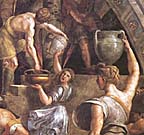 Last night I watched a "Secrets of the Dead" presentation on PBS about the great fire of Rome. I think I've seen it before but I couldn't remember. Anyway, it sounds as if Art historian Eric Varner seem to think that Nero really didn't have anything to do with it. It was just an unfortunate event that he eventually was blamed for. The narrator said that one of the reasons that archaeologists think it was not set by Nero was that it began in the poor district over by the Circus Maximus. Nero's primary support base was the poor. It was the senators that didn't support him. The program also mentioned that Nero rushed back to Rome and provided food and shelter for the thousands that were left homeless following the disaster. This does not sound like someone who would have intentionally set the fire. The program also demonstrated how the contents of the rich marble and stone villas would have provided ample fuel for the spread of the fire in the wealthier districts, especially after the fire had reached the level of a firestorm in the highly inflammable tenements of the suburra.
Last night I watched a "Secrets of the Dead" presentation on PBS about the great fire of Rome. I think I've seen it before but I couldn't remember. Anyway, it sounds as if Art historian Eric Varner seem to think that Nero really didn't have anything to do with it. It was just an unfortunate event that he eventually was blamed for. The narrator said that one of the reasons that archaeologists think it was not set by Nero was that it began in the poor district over by the Circus Maximus. Nero's primary support base was the poor. It was the senators that didn't support him. The program also mentioned that Nero rushed back to Rome and provided food and shelter for the thousands that were left homeless following the disaster. This does not sound like someone who would have intentionally set the fire. The program also demonstrated how the contents of the rich marble and stone villas would have provided ample fuel for the spread of the fire in the wealthier districts, especially after the fire had reached the level of a firestorm in the highly inflammable tenements of the suburra.
Archeologist Andrea Carandini disagrees. "Everything was destroyed," he says, "there was not one single house standing." Specifically, Carandini explains that fire destroyed the portion of the Forum where the senators lived and worked. "All these houses were destroyed, so the aristocracy didn't have a proper place to live," he says. The open mall in the middle of the Forum remained, but it became a sort of shopping mall, a commercial center "built on the top of aristocratic Rome ... so it's the end, in a way, of the power of the aristocracy in Rome."
Monday, October 06, 2003
Ancient Visionary Mostly Ignored by Modern Scholars
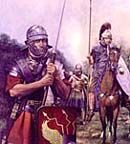 "In the late fourth century A.D., a citizen of the Roman Empire wrote a treatise known to history as De Rebus Bellicis (On Matters of Warfare). The author, whose name is unknown, offered dramatic proposals for inventions and reforms to shore up the Empire's defense. The manuscript was addressed to the highest level: the Emperor himself.
"In the late fourth century A.D., a citizen of the Roman Empire wrote a treatise known to history as De Rebus Bellicis (On Matters of Warfare). The author, whose name is unknown, offered dramatic proposals for inventions and reforms to shore up the Empire's defense. The manuscript was addressed to the highest level: the Emperor himself.
Among the proposals (complete with illustrations) were an oxen-powered warship, a portable bridge, and new types of chariots and artillery. Anonymous (as I'll call the author) pressed for an expansion of border fortifications and faster promotion and discharge of soldiers. Anonymous also called for nonmilitary reforms, including changes in the monetary and legal systems and an end to corruption by provincial officials."
Author of 'The Manchurian Candidate' charged with plagiarizing "I, Claudius"
 C.J. Silverio, a software engineer in Menlo Park says author Richard Condon plagiarized "I, Claudius" in his famous novel "The Manchurian Candidate.
C.J. Silverio, a software engineer in Menlo Park says author Richard Condon plagiarized "I, Claudius" in his famous novel "The Manchurian Candidate.
"She picked up Condon's novel after seeing the 1962 John Frankenheimer film starring Frank Sinatra, and early on in the book read, 'Johnny knew in his superstitious heart of hearts that his marriage to Raymond's mother was an impious thing and this knowledge, it seems, affected him nervously, putting an inner restraint upon his flesh.'
' 'Impious?' I said. 'Inner restraint on his flesh?' I've read that sentence before,' Silverio wrote. 'I went to the straight-fiction bookshelves and found 'I, Claudius' and read the original passage.' The original passage reads, 'He knew that the marriage was impious: this knowledge, it seems, affected him nervously, putting an inner restraint on his flesh.'
This was but one of many phrases and word choices similar to those in 'I, Claudius' that Silverio discovered, and she ran on her Weblog excerpts from each book side by side for people to look at for themselves. "
See her weblog at: http://www.blackbook.org/1998/06/980621.html
Monday, September 29, 2003
Virgil Lives!
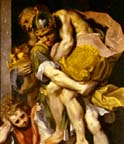 "EVE ADLER, a classicist at Middlebury College in Vermont, may have just changed all Virgil's post-Renaissance diminished position in literature with her new book, 'Vergil's Empire: Political Thought in the Aeneid.' After this analysis, it will be difficult to think of Virgil merely as a gifted imitator of Homer. If Adler is right, Virgil had ambitions at least as grand as his Greek predecessor--and with good reason."
"EVE ADLER, a classicist at Middlebury College in Vermont, may have just changed all Virgil's post-Renaissance diminished position in literature with her new book, 'Vergil's Empire: Political Thought in the Aeneid.' After this analysis, it will be difficult to think of Virgil merely as a gifted imitator of Homer. If Adler is right, Virgil had ambitions at least as grand as his Greek predecessor--and with good reason."
"'Vergil's Empire' draws heavily on Leo Strauss for the political analysis of the 'Aeneid.' Something of a secret teaching may be glimpsed behind the imperial screen, she argues, which emerges most clearly near the center of the text, where Aeneas' descent into the underworld signals the shift from wandering to battles. But her sensitive and penetrating reading of many passages in the 'Aeneid' does not reduce Virgil to a Procrustean bed of Straussian proportions. This book is stunningly original. Indeed, Adler's account of Virgil's views on universal empire has urgency not only for literary studies but for our reflections on empire in the current global situation.
Adler believes that Virgil is powerfully grappling not only with Homer, but with Lucretius, his Latin predecessor in the first century B.C"
Friday, September 19, 2003
Aram Khachaturian centennial special "Spartacus" presented in Pasadena
 I noticed that in honor of the 100th anniversary of Soviet composer Aram Khachaturian’s birth, the Pasadena Civic Auditorium presented his ballet “Spartacus” this week.
I noticed that in honor of the 100th anniversary of Soviet composer Aram Khachaturian’s birth, the Pasadena Civic Auditorium presented his ballet “Spartacus” this week.
In 1968, Grigorovich and the Bolshoi Ballet gave their first performance of "Spartacus,'' a ballet about an uprising of gladiators and slaves under the leadership a courageous Thacian named Spartacus and their defeat by the imperial Roman commander Crassus and his troops. Guided by his intense quest for freedom, Spartacus struggles against the cruel Crassus and his army.
In 1984, a television production captured the ballet's power as Grigorovich's choreography filled the screen with dynamic scenes of tension and conflict, which give full expression to the virility and strength for which Russia's male dancers are renowned. This 1984 performance was directed by Danish director, Preben Montell.
Hear clips from the work:
New software creates faces faster!
 "Software that reconstructs faces from skulls has been developed by researchers from the Max Planck Institute for Computer Science in Germany. The software starts with a 3D laser scan of a skull, adds markers to indicate tissue depth, then builds layers of muscles and skin.
"Software that reconstructs faces from skulls has been developed by researchers from the Max Planck Institute for Computer Science in Germany. The software starts with a 3D laser scan of a skull, adds markers to indicate tissue depth, then builds layers of muscles and skin.
The method could speed forensic work, and could also be used to reconstruct long-extinct animal species, said Kolja K?hler, a researcher at the Max Planck Institute.
The idea came about when the researchers used an anatomy-based approach for facial modeling and animation. "One of the major problems there was shaping... anatomical structures to fit a given 3D skin model," said K?hler. The researchers later realized that the method could be inverted. "Using just about the same math, it is also possible to start from a virtual skull model and construct the muscle layer and skin on top of that," he said.
I find this development very exciting. I have always been fascinated by the virtual reconstructions of historical figures from skulls that have been found in excavations. This process may make it much less expensive and make it possible to build a database of faces from the past! I only regret that most Romans were cremated so we probably will never know if the sculptures left behind of many famous Romans were truly accurate.
See also: http://www.fbi.gov/hq/lab/fsc/backissu/jan2001/phillips.htm
http://www.shef.ac.uk/assem/1/evison.html
http://www.pbs.org/wgbh/nova/first/kennewick.html
http://www.shef.ac.uk/staff/newsletter/vol24no9/page06.html
Sella Curulis Inspired 19th Century American Federal Furniture Designers
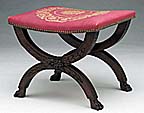 "The ways in which ancient Greek and Roman designs served as inspiration for classical revival furniture in early 19th-century America are explored in the Yale University Art Gallery's newest exhibition, 'Curule: Ancient Design in American Federal Furniture' . The sella curulis, one of the principal emblems of political authority in ancient Rome, had two hinged S-shaped legs at each end, with a seat frame created by fitting notched side rails onto the fixed front and back rails, with a leather seat stretched between them.
"The ways in which ancient Greek and Roman designs served as inspiration for classical revival furniture in early 19th-century America are explored in the Yale University Art Gallery's newest exhibition, 'Curule: Ancient Design in American Federal Furniture' . The sella curulis, one of the principal emblems of political authority in ancient Rome, had two hinged S-shaped legs at each end, with a seat frame created by fitting notched side rails onto the fixed front and back rails, with a leather seat stretched between them.
A 16th-century version of the sella curulis is depicted in a drawing from the gallery's collection by Giulio Romano of a scene in which the stool is transformed into a chair for the Roman general Coriolanus. Also in the exhibition is a group of early 19th-century books of architectural and decorative designs by Thomas Hope, George Smith and Charles Heathcote Tatham, published in England, in which the sella curulis is featured. American craftsmen drew upon these, as well as French publications by Pierre de la Mésangère, and Percier and Fontaine for their versions of curule-based furniture.
See also: http://www.designboom.com/eng/education/folding/greek.html
Wednesday, September 17, 2003
Actium comes to life on "Moments In Time"
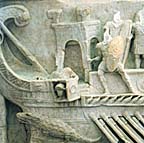 Last week I watched a Discovery Channel series called “Moments in Time” featuring the battle at Actium. I was quite surprised by the scientists’ estimated size of Antony’s war galleys. They said that each one was about the size of a football field and had up to 600 rowers. Apparently, they were able to estimate the size of the galleys from the relative size of the ships’ beaks that once adorned the Augustus' memorial near the site of his victory. Archaeologists have found the stones that were carved out to embed the beaks. The computer-generated recreation was quite vivid as well showing the use of fire bolts and huge round stones launched at the opposing ships. It very much resembled Vergil’s description in the Aeneid:
Last week I watched a Discovery Channel series called “Moments in Time” featuring the battle at Actium. I was quite surprised by the scientists’ estimated size of Antony’s war galleys. They said that each one was about the size of a football field and had up to 600 rowers. Apparently, they were able to estimate the size of the galleys from the relative size of the ships’ beaks that once adorned the Augustus' memorial near the site of his victory. Archaeologists have found the stones that were carved out to embed the beaks. The computer-generated recreation was quite vivid as well showing the use of fire bolts and huge round stones launched at the opposing ships. It very much resembled Vergil’s description in the Aeneid:
Across the center of the shield were shown
the ships of brass, the strife of Actium:
you might have seen all of Leucata's bay
teeming with war's array, waves glittering
with gold. On his high stern Augustus Caesar
is leading the Italians to battle,
together with the senate and the people,
the household gods and Great Gods; his bright brows
pour out a twin flame, and upon his head
his father's Julian star is glittering.
Elsewhere Agrippa towers on the stern;
with kindly winds and gods he leads his squadron;
around his temples, glowing bright, he wears
the naval crown, magnificent device,
with its ships' beaks. And facing them, just come
from conquering the peoples of the dawn,
from the red shores of the Erythraean Sea--
together with barbaric riches, varied
arms--is Antonius. He brings with him
Egypt and every power of the East
and farthest Bactria; and--shamefully--
behind him follows his Egyptian wife.
The squadrons close headlong; and all the waters
foam, torn by drawn-back oars and by the prows
with triple prongs. They seek the open seas;
you could believe the Cyclades, uprooted,
now swam upon the waters or steep mountains
had clashed with mountains as the crewmen thrust
in their great galleys at the towering sterns.
Torches of hemp and flying darts of steel
are flung by hand, and Neptune's fields are red
with strange bloodshed. Among all this the queen
calls to her squadrons with their native sistrum;
she has not yet looked back at the twin serpents
that swim behind her. Every kind of monster
god--and the barking god, Anubis, too--
stands ready to cast shafts against Minerva
and Venus and at Neptune. In the middle
of all the struggle, Mars, engraved in steel,
rages beside fierce Furies from the sky;
and Discord, joyous, strides in her rent robe;
Bellona follows with a bloodstained whip.
But Actian Apollo, overhead,
had seen these things; he stretched his bow; and all
of Egypt and of India, and all
the Arabs and Sabaeans, turned their backs
and fled before this terror. The queen herself
was seen to woo the winds, to spread her sails,
and now, yes now, let fall the slackened ropes.
The Lord of Fire had fashioned her within
the slaughter, driven on by wave and west wind,
pale with approaching death; but facing this,
he set the Nile, his giant body mourning,
opening wide his folds and all his robes,
inviting the defeated to his blue-gray
breast and his sheltering streams. But entering
the walls of Rome in triple triumph, Caesar [ Octavian Augustus]
was dedicating his immortal gift
to the Italian gods: three hundred shrines
throughout the city. And the streets reechoed
with gladness, games, applause; in all the temples
were bands of matrons, and in all were altars;
and there, before these altars, slaughtered steers
were scattered on the ground. Caesar himself
is seated at bright Phoebus' snow-white porch,
and he reviews the spoils of nations and
he fastens them upon the proud doorposts.
The conquered nations march in long procession,
as varied in their armor and their dress
as in their languages....
Tuesday, September 16, 2003
Supermarket molluscs reveal Roman secret
"John Edmonds, A British amateur chemist, has worked out how the ancient Romans dyed the togas of emperors this deep colour thanks to a bacterium found in cockles from the supermarket Tesco. He explained to the British Association science festival in Salford, Greater Manchester, how he rediscovered the secret of imperial purple after studying the fermentation process of indigo pigments from the woad plant.
With help of researchers in Reading and from Israel he has been able to establish the vital role played by a bacterium in chemically reducing (the addition of electrons) the ancient pigments so that they will dissolve in a dye solution.
With help of researchers in Reading and from Israel he has been able to establish the vital role played by a bacterium in chemically reducing (the addition of electrons) the ancient pigments so that they will dissolve in a dye solution.
Tuesday, September 09, 2003
Hygiene in Ancient Rome
 "'Florence Dupont (Daily Life in Ancient Rome) writes that it was for reasons of ritual that the Romans washed frequently. And she adds that '. . . even in very ancient times and even in the depth of the country, Romans, including women and slaves, would wash every day and would have a thorough bath on every feast day if not more often. At Rome itself, baths were taken daily.
"'Florence Dupont (Daily Life in Ancient Rome) writes that it was for reasons of ritual that the Romans washed frequently. And she adds that '. . . even in very ancient times and even in the depth of the country, Romans, including women and slaves, would wash every day and would have a thorough bath on every feast day if not more often. At Rome itself, baths were taken daily.
'According to her, the admission fee at public baths was one-quarter as. [Affordable for pretty much everyone.]
'Joachim Marquardt (Das Privatleben der R?mer) writes that fees differed, mentions one-quarter to one as for men, but always one full as for women, and that children got in free. He also writes that life-long free baths might be bequeathed in wills. That in itself seems to stress the importance of bathing. "
Monday, September 08, 2003
A History of Rome, by Robert F. Pennell (1890)
"Fourteen miles from the mouth of the Tiber, the monotonous level of the plain through which the river flows is broken by a cluster of hills [Footnote: The seven hills of historic Rome were the Aventine, Capitoline, Coelian, Esquiline (the highest, 218 feet), Palatine, Quirínal, and Viminal. The Janiculum was on the other side of the Tiber, and was held by the early Romans as a stronghold against the Etruscans. It was connected with Rome by a wooden bridge (_Pons Sublicius_).] rising to a considerable height, around one of which, the PALATINE, first settled a tribe of Latins called RAMNES, -- a name gradually changed to ROMANS.
When this settlement was formed is not known. Tradition says in 753. It may have been much earlier. These first settlers of Rome were possibly a colony from Alba. In the early stages of their history they united themselves with a Sabine colony that had settled north of them on the QUIRÍNAL HILL. The name of TITIES was given to this new tribe. A third tribe, named LUCERES, composed, possibly, of conquered Latins, was afterwards added and settled upon the COELIAN HILL. "
When this settlement was formed is not known. Tradition says in 753. It may have been much earlier. These first settlers of Rome were possibly a colony from Alba. In the early stages of their history they united themselves with a Sabine colony that had settled north of them on the QUIRÍNAL HILL. The name of TITIES was given to this new tribe. A third tribe, named LUCERES, composed, possibly, of conquered Latins, was afterwards added and settled upon the COELIAN HILL. "
Wednesday, September 03, 2003
Art Treasures of the Hittites, Ottomans, and Byzantine Empires Featured in New Exhibit
"Readers of the Bible probably know the Hittites as a people who were a source of land and wives for Old Testament patriarchs--including King David, who ordered the beautiful Bathsheba into his bed and then arranged for the death of Uriah, her inconvenient Hittite husband. But Hittites were not always ill-fated bit players in someone else's story. According to information provided at Three Great Civilizations in Turkey, an art exhibition now at the Tokyo Metropolitan Museum of Art, the Hittites had their time in the sun from the 20th to 13th centuries B.C. They were the first people to use iron, and they controlled an area that corresponds with present-day Turkey and Syria. Of the subsequent empires and kingdoms to ebb and flow across what is now Turkey, two more are featured in this show: the Byzantine and Ottoman empires. "
In addition to figurines and statuettes, the exhibition includes ceremonial vessels, official seals and 22 clay writing tablets. They include letters, legal codes and instructions on how to train horses or conduct birth rituals.
The exhibition will be held at the Fukuoka Asian Art Museum in Fukuoka, Oct. 12-Dec. 7 and the Osaka Museum of History in Osaka, Dec. 20-Feb. 16.
In addition to figurines and statuettes, the exhibition includes ceremonial vessels, official seals and 22 clay writing tablets. They include letters, legal codes and instructions on how to train horses or conduct birth rituals.
The exhibition will be held at the Fukuoka Asian Art Museum in Fukuoka, Oct. 12-Dec. 7 and the Osaka Museum of History in Osaka, Dec. 20-Feb. 16.
Tuesday, September 02, 2003
The Achievements of Augustus Caesar
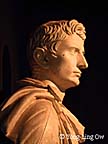 by Ling Ouyang
by Ling Ouyang
"The most consummate politician Rome had ever seen”, Augustus 'displayed a consummate ability to utilise people’s services, to play men off against each other, and to maintain a convincing self-righteousness in the most unpromising of situations'. 'He became expert at transferring the blame for any disturbance onto his opponents, while presenting himself as the innocent injured party'. 'Such were the ingredients of charisma in a man who from his earliest years proved himself to be a mature demagogue and a deft manipulator of opinion'. But more importantly, Augustus was a masterly statesman—'He worked ceaselessly to maintain the order thus established, and nearly every part of his great empire had reasons to be grateful for increased security, expanding prosperity, and added amenity of life'. "
Tuesday, August 26, 2003
Roman Legions Not Just Cabbage Freaks
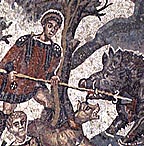 The Roman Military Diet By R.W. Davies
The Roman Military Diet By R.W. Davies
"We've been led to think that ancient Romans were mainly vegetarian and that when the legions came into contact with the European barbarians they had trouble stomaching the meat-rich food. "
"...there is evidence from the Republican period of Roman history for meat consumption by soldiers: "When Scipio reintroduced military discipline to the army at Numania in 134 B.C., he ordered that the only way the troops could eat their meat was by roasting or boiling it." Q. Caecilius Metellus Numidicus made a similar rule in 109 B.C."
In a related discussion, D.C. Reynolds points out, "The tradition about the legions being near vegetarian in camp is very believable for the early Republican era. Scurvy references are reliable, I believe. By the latter half of the 2nd century B.C., the whole Roman world had opened up and almost all aspects of Roman life, including diet, had changed from the 'old days.' My only real point is that Josephus and Tacitus could not accurately chronicle the early or middle Republican diet. Cato is the only source that comes close, and he is at the very end of the era (and a cabbage freak to boot)."
I didn't know Cato the Younger was so fond of cabbage. That may have accounted for his aversion to eating flesh during his "March of the 10,000" as recounted by Colleen McCullough in "The October Horse".
The Religion of Numa And Other Essays on the Religion of Ancient Rome
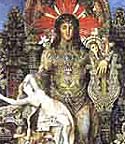 By Jesse Benedict Carter [1906]
By Jesse Benedict Carter [1906]
"ROME forms no exception to the general rule that nations, like individuals, grow by contact with the outside world. In the middle of the five centuries of her republic came the Punic wars and the intimate association with Greece which made the last half of her history as a republic so different from the first half; and in the kingdom, which preceded the republic, there was a similar coming of foreign influence, which made the later kingdom with its semi-historical names of the Tarquins and Servius Tullius so different from the earlier kingdom with its altogether legendary Romulus, Numa, Tullus Hostilius and Ancus Martins. We have thus four distinct phases in the history of Roman society, and a corresponding phase of religion in each period;"
Late Roman Excavations prove challenging in North Africa
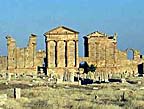 THE URBAN TRANSITION IN THE MAHGREB by Stephen Roskams, University of York
THE URBAN TRANSITION IN THE MAHGREB by Stephen Roskams, University of York
"Urban life was vital to Rome, so towns are a natural focus for those considering developments beyond the fourth century [in North Africa]. However, problems abound with the archaeological evidence for the p e r i o d . Practical obstacles are created by the diverse organisation of fieldwork in the different countries of North Africa, which limits comparability between regions.To this can be added the technical difficulty of defining tenuous stratigraphic distinctions in a dry climate. Additional methodological problems relate to the nature of post-Roman material culture. These include its complex sequences of buildings utilising diverse construction techniques; the later robbing of building stone dividing sequences into separate islands, with few diagnostic deposits to aid correlations between them; and the issue of finds residuality, since many artefacts were used for considerable lengths of time and then, at the end of their “normal” life, were either intentionally re-cycled as building material or simply redeposited when subsequent occupation churned up debris from earlier periods (for example, it is not uncommon for the vast majority of finds from provably post-Roman levels to be Roman in date). Finally, numismatic evidence rarely clarifies the dating of sequences as many coins are illegible and some areas produced no local coinage at particular points in time (for example the Carthage mint between AD420-80).
Monday, August 25, 2003
Lucan's Anti-Epic: Bellum Civile
 "To the extent that circumstance allowed, the Aeneid was used as a negative compositional model for the Bellum Civile. Lucan skillfully adapts (often by inversion or negation) the traditional elements of the genre to his new, 'anti-epic' purpose. Throughout the poem, the challenge of stylistic innovation called for in the narration of the nefas (wickedness) of civil war is forcefully met."
"To the extent that circumstance allowed, the Aeneid was used as a negative compositional model for the Bellum Civile. Lucan skillfully adapts (often by inversion or negation) the traditional elements of the genre to his new, 'anti-epic' purpose. Throughout the poem, the challenge of stylistic innovation called for in the narration of the nefas (wickedness) of civil war is forcefully met."
"A fierce passion can be detected in almost any passage of the Bellum Civile, most often a relentless, seething anger directed at those held responsible for the collapse of the Roman Republic, or a deeply-felt horror at the perversity and cost of civil war. "
Thursday, August 21, 2003
Roman Wine: A Window on an Ancient Economy
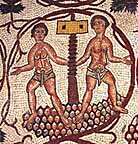 "The story of Roman winemaking is by no means a simple one. It spans more than eight centuries of Old World history and a geographic range from southern Scotland to the middle reaches of the Nile. What makes the story so fascinating is how wine is such a clear window into Roman everyday life. The changing nature of wine's trade time-and-again was linked strongly to the tide of Roman politics, and various aspects of its consumption serve as an unsubtle measure of social division, rich versus poor."
"The story of Roman winemaking is by no means a simple one. It spans more than eight centuries of Old World history and a geographic range from southern Scotland to the middle reaches of the Nile. What makes the story so fascinating is how wine is such a clear window into Roman everyday life. The changing nature of wine's trade time-and-again was linked strongly to the tide of Roman politics, and various aspects of its consumption serve as an unsubtle measure of social division, rich versus poor."
Etruscan jewelry from the Vatican featured in exhibit
 The Mabee-Gerrer Museum will be the only venue in the United States to feature the exhibit 'Unveiling Ancient Mystery: Etruscan Treasures.' It will be in Shawnee, Oklahoma from June 1 through Oct. 31, 2004, before heading back to the Vatican in Rome.
The Mabee-Gerrer Museum will be the only venue in the United States to feature the exhibit 'Unveiling Ancient Mystery: Etruscan Treasures.' It will be in Shawnee, Oklahoma from June 1 through Oct. 31, 2004, before heading back to the Vatican in Rome.
The exhibit will have more than 100 pieces of Etruscan gold jewelry and 30 pieces of Etruscan bronze and terracotta artifacts from the private collections of the director general of the Vatican Museums, Italian Prince Fabrizio Alliata and the Gregorian-Etruscan Museum of the Vatican Museums. This will be the first time for many of the Vatican Museums' pieces to be exhibited abroad and the first time the gold jewelry has ever been exhibited.
Wednesday, August 13, 2003
The History of Chronology
By Henry C K Liu
"In chronology, an era is a period reckoned from an artificially fixed point in time, as before or after the birth of Christ: BC for Before Christ and AD for Anno Domini (year of the Lord). There are less known but also significant points in historical time beside the birth of Christ. The alleged creation of the world in Jewish mythical history is equivalent to 3761 BC, and in Byzantine history, the creation date was 5508 BC. The founding of the city of Rome took place in 753 BC, with subsequent years marked AUD for ad urbe condita (from the founding of the city). The hijira marks the migration of the Prophet Mohammed to Medina from Mecca in AD 622. Abbreviated AH, it is the starting timepost for all Muslims. "
"Periodization, a complex problem in history, is the attempt to categorize or divide historical time, mentality or events into discrete named blocks. History is in fact continuous, and so all systems of periodization are to some extent arbitrary. History does not end as long as the human species survives. Those who proclaim the end of history are predicting the death of civilization, not the victory of neo-liberalism as heaven on Earth."
"It is nevertheless useful to segment history so that the past can provide lessons to the present by being conceptually organized and significant changes over time articulated. Different peoples and cultures have different histories, and so will need different models of periodization. Periodizing labels constantly change and are subject to redefinition as contemporary perceptions change. A historian may claim that there is no such thing as modernity, or the Enlightenment or the Renaissance, or the Nuclear Age, while others will defend the concept."
Although Liu obviously nurses a particular political bias, I found this article interesting. Although it is not purely about the Roman Empire, there is an extensive discussion of this authori's viewpoint of what constituted the formation of the Holy Roman Empire and the political environment surrounding that formation.
"In chronology, an era is a period reckoned from an artificially fixed point in time, as before or after the birth of Christ: BC for Before Christ and AD for Anno Domini (year of the Lord). There are less known but also significant points in historical time beside the birth of Christ. The alleged creation of the world in Jewish mythical history is equivalent to 3761 BC, and in Byzantine history, the creation date was 5508 BC. The founding of the city of Rome took place in 753 BC, with subsequent years marked AUD for ad urbe condita (from the founding of the city). The hijira marks the migration of the Prophet Mohammed to Medina from Mecca in AD 622. Abbreviated AH, it is the starting timepost for all Muslims. "
"Periodization, a complex problem in history, is the attempt to categorize or divide historical time, mentality or events into discrete named blocks. History is in fact continuous, and so all systems of periodization are to some extent arbitrary. History does not end as long as the human species survives. Those who proclaim the end of history are predicting the death of civilization, not the victory of neo-liberalism as heaven on Earth."
"It is nevertheless useful to segment history so that the past can provide lessons to the present by being conceptually organized and significant changes over time articulated. Different peoples and cultures have different histories, and so will need different models of periodization. Periodizing labels constantly change and are subject to redefinition as contemporary perceptions change. A historian may claim that there is no such thing as modernity, or the Enlightenment or the Renaissance, or the Nuclear Age, while others will defend the concept."
Although Liu obviously nurses a particular political bias, I found this article interesting. Although it is not purely about the Roman Empire, there is an extensive discussion of this authori's viewpoint of what constituted the formation of the Holy Roman Empire and the political environment surrounding that formation.
Thursday, August 07, 2003
Herbal Contraception in Ancient Times
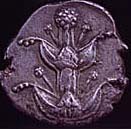 By David W. Tschanz
By David W. Tschanz
"In the seventh century BC, Greek colonists established the city of Cyrene on the Libyan coast. Shortly after their arrival, wrote the Greek botanist Theophrastus (ca. 370-288 BC), they discovered silphium -- the plant that would make them rich and the city famous. A member of the genus Feula, (commonly known as giant fennel), a large group of plants with deeply divided leaves and yellow flowers, the pungent sap from silphium's stems and roots was used in cough syrups. It also gave food a rich distinctive taste when used as an additive. Of far greater importance was its value as a birth control agent. "
Monday, August 04, 2003
The Syrian War
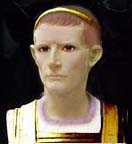 I am still listening to Harold Lamb’s biography of Hannibal and was surprised that he considered the Roman “liberation” of Greece by Titus Quinctius Flamininus and the resulting power vacuum that was created when the legions withdrew after defeating Philip V of Macedon at the battle of Cynoscephalae, an intentional ploy by the Romans to lure Antiochus III into a confrontation. He indicated Hannibal recognized it as a trap and tried to warn Antiochus but the great king did not listen to him.
I am still listening to Harold Lamb’s biography of Hannibal and was surprised that he considered the Roman “liberation” of Greece by Titus Quinctius Flamininus and the resulting power vacuum that was created when the legions withdrew after defeating Philip V of Macedon at the battle of Cynoscephalae, an intentional ploy by the Romans to lure Antiochus III into a confrontation. He indicated Hannibal recognized it as a trap and tried to warn Antiochus but the great king did not listen to him.
In an earlier lecture (I think by Professor Garrett Fagan) on Roman History, I understood Dr. Fagan to point to the Roman withdrawal from Greece as an indication that Rome at that point in time still did not have imperial aspirations in the east.
This lecture by Professor Christopher Mackay at the University of Alberta provides quite a bit of background which makes it sound like the Romans definitely had plans for the eastern Mediterranean.
Sunday, August 03, 2003
Vindolanda Tablets Now Online
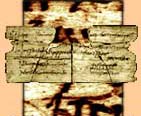 In "Letters From The Roman Front", a program on the Discovery Channel, the discovery of correspondence written on thin pieces of wood was considered the most important of all the items recovered at the site because these letters provided first hand accounts of daily life in that period of the Roman Empire. Now, scholars have translated the documents and provided their text in its entirety online for everyone to read and study. What a wonderful resource.
In "Letters From The Roman Front", a program on the Discovery Channel, the discovery of correspondence written on thin pieces of wood was considered the most important of all the items recovered at the site because these letters provided first hand accounts of daily life in that period of the Roman Empire. Now, scholars have translated the documents and provided their text in its entirety online for everyone to read and study. What a wonderful resource.
Even small fragments can raise interesting issues. For example, in one letter to Lucius the decurion, a friend writes "A friend sent me fifty oysters from Cordonovi." Since Vindolanda is not on the coast and seafood spoils quickly, it suggests transporation systems were apparently well developed and hostilities must have been marginal at that time to effect this type of delivery.
Thursday, July 31, 2003
Trajan's Rome: The Man, The City, The Empire
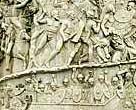 This Interdisciplinary Middle School Curriculum Unit developed by the Getty Museum includes:
This Interdisciplinary Middle School Curriculum Unit developed by the Getty Museum includes:
Lesson I: Trajan: The Man and His Empire
Lesson II: The People of Trajan’s Rome
Lesson III: Building Trajan’s City
Lesson IV: Governing Trajan’s City and Empire
Lesson V: Provisioning Imperial Rome
Lesson VI: Entertainment in Imperial Rome
The materials provided include a bibliography, an image gallery, a glossary, and virtual tour of the Forum of Trajan.
The Early Roman calendar
 "The Romans borrowed parts of their earliest known calendar from the Greeks. The calendar consisted of 10 months in a year of 304 days. The Romans seem to have ignored the remaining 61 days, which fell in the middle of winter. The 10 months were named Martius, Aprilis, Maius, Junius, Quintilis, Sextilis, September, October, November, and December. The last six names were taken from the words for five, six, seven, eight, nine, and ten. Romulus, the legendary first ruler of Rome, is supposed to have introduced this calendar in the 700's B.C.E.
"The Romans borrowed parts of their earliest known calendar from the Greeks. The calendar consisted of 10 months in a year of 304 days. The Romans seem to have ignored the remaining 61 days, which fell in the middle of winter. The 10 months were named Martius, Aprilis, Maius, Junius, Quintilis, Sextilis, September, October, November, and December. The last six names were taken from the words for five, six, seven, eight, nine, and ten. Romulus, the legendary first ruler of Rome, is supposed to have introduced this calendar in the 700's B.C.E.
According to tradition, the Roman ruler Numa Pompilius added January and February to the calendar. This made the Roman year 355 days long. To make the calendar correspond approximately to the solar year, Numa also ordered the addition every other year of a month called Mercedinus. Mercedinus was inserted after February 23 or 24, and the last days of February were moved to the end of Mercedinus. In years when it was inserted, Mercedinus added 22 or 23 days to the year."
Glassmaking In Roman Times
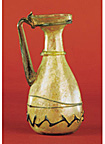 In Natural History XXXVI.192, Pliny the Elder said the invention of glass occurred on the Palestinian coast. He claimed that as natron merchants were sailing from Egypt, they brought their ships to shore at the mouth of the Belus River near Ptolemais. Lacking stones, they used some of their cargo to hold up their cooking pots. The heat from the fire caused the mixture of soda-rich natron and sand to fuse into glass.
In Natural History XXXVI.192, Pliny the Elder said the invention of glass occurred on the Palestinian coast. He claimed that as natron merchants were sailing from Egypt, they brought their ships to shore at the mouth of the Belus River near Ptolemais. Lacking stones, they used some of their cargo to hold up their cooking pots. The heat from the fire caused the mixture of soda-rich natron and sand to fuse into glass.
Creative as this story sounds, however, the heat from a cooking fire would never reach the desired temperature for full fusion of glass. We now believe the invention of glass occurred around 2200 B.C. in northwestern Iran. Chemistry for the coloration of glass was already in place during the reign of Tutankhamun in Egypt (circa 1330 B.C.), and colored glass was heavily exploited for furniture and architectural inlay for several centuries thereafter. Although the Romans had nothing to do with the invention of glass, during the first century A.D. they did play a primary role in the industrialization of the glassmaking process in the Mediterranean world.
Wednesday, July 30, 2003
Taboo, Magic, Sprits: A Study of Primitive Elements in Roman Religion
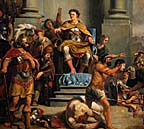 By ELI EDWARD BURRISS (1931)
By ELI EDWARD BURRISS (1931)
"So in the old Roman days Titus Manlius, having killed a gigantic Gaul in a hand-to-hand conflict, cut off the Gaul's head, 'wrenched off his necklace and placed it, reeking with blood, on his own neck.' From that time on he and his descendants bore the surname Torquatus (torques--a chain or necklace). 1 The family of Torquatus had the necklace as a device down to the time of the Emperor Caligula, who forbade its use. 2 Again, in a much later time, during one of the pagan persecutions, a Christian, Saturus, was thrown to the leopards. A single gnash of the wild beast bathed him in blood. Turning to a soldier who was also, but in secret, a Christian, he asked for the ring which he was wearing; and when the soldier gave it to him, he smeared it with his own lifeblood and handed it back. 3
These are not merely the actions of a bloodthirsty soldier, crazed with victory, and of a religious fanatic. It was the inability to think correctly that caused Torquatus to place the gory necklace of his slain opponent about his own neck, and that impelled Saturus to smear the ring of his fellow Christian with his own blood and hand it back to him.
The curious twist in thinking which produced these actions has been considered a characteristic of the so-called age of magic;"
Catullus and His Wedding Songs
 by Jennifer Goodall Powers, SUNY Albany, NY
by Jennifer Goodall Powers, SUNY Albany, NY
Yet if human survival means more than a ghostly reputation,
Tibullus must surely dwell in Elysium,
Welcomed by young Calvus, ivy-garlanded,
by Catullus poet and scholar ...
"Gaius Valerius Catullus fell in love with a married woman in the first century B.C. and then chronicled the affair in his poetry. Many of Catullus' poems are dedicated to the woman called Lesbia whom he loved with his whole life. Out of this relationship and influenced by Greek poets, a new Latin genre was created. Catullus and his fellow Roman poets, however, added a dimension of devoted love to their poems that was rare in Hellenistic poetry. Influenced by the changing morality in Rome and his subsequent love affair, Catullus' poems disclose not only his own emotions (as one of the first poets to write this in depth about his love affair), but also this new Roman attitudes towards marriage and women."
See also: http://catullus.iscool.net/
Tuesday, July 29, 2003
Caesar and the Starving Gauls at Alesia
 I was conducting research on the Mandubians, the tribe that originally inhabited Alesia, today and found an excerpt from Caesar’s commentaries that is missing from MIT’s Internet Classics Archives. I was particularly interested in it because it mentioned the starving Gallic women and children depicted in the recent miniseries.
I was conducting research on the Mandubians, the tribe that originally inhabited Alesia, today and found an excerpt from Caesar’s commentaries that is missing from MIT’s Internet Classics Archives. I was particularly interested in it because it mentioned the starving Gallic women and children depicted in the recent miniseries.
"The Mandubii, who had taken the others into their oppidum [1], were forced to leave it with their wives and children. When they came up to our fortifications, they wept and begged the soldiers to take them as slaves and give them something to eat. But I had guards posted all along the rampart with orders not to allow any of them inside our lines. " – Gaius Julius Caesar, The Gallic Wars, Book 7 chapters 63 – 90, as translated by Anne and Peter Wiseman.
The Internet Classics Archives provides a copy translated by W. A. McDevitte and W. S. Bohn. Its Book 7 stops at Chapter 59. However, the Archives server crashed a couple of years ago and after that I noticed several missing sections of other works. Maybe some of The Gallic Wars was affected as well.
I did notice, however, that Caesar's account does not mention that the outcasts were also rejected by Vercingetorix and starved before the gates. Maybe that was a little hollywood artistic license.
Monday, July 28, 2003
Faces of Egypt: From Ghiza to Fayum Displayed at the Megaron Mousikis
 "In 332 BC, Alexander the Great conquered Egypt and for the next three centuries, the Macedonian dynasty of the Ptolemies ruled the country from its capital Alexandria. In 31 BC, the Romans defeated the last Ptolemaic ruler, Queen Cleopatra VII. Egypt fell to Octavian Caesar but Greek remained the official language. In the cross-cultural Roman Egypt that emerged. For some reason Libyans, Romans, Greeks and Jews all developed a taste for mummy portraits. "
"In 332 BC, Alexander the Great conquered Egypt and for the next three centuries, the Macedonian dynasty of the Ptolemies ruled the country from its capital Alexandria. In 31 BC, the Romans defeated the last Ptolemaic ruler, Queen Cleopatra VII. Egypt fell to Octavian Caesar but Greek remained the official language. In the cross-cultural Roman Egypt that emerged. For some reason Libyans, Romans, Greeks and Jews all developed a taste for mummy portraits. "
These finds are not recent. Several such portraits were discovered in the 1880s but were then dispersed worldwide and ignored. Talented Greek painter, Euphrosyne Doxiadis explains, "Archaeologists declined to comment on their quality as works of art. Art historians have been shy of archaeology. To Egyptologists they are not Egyptian. To specialists in Greco-Roman art they are. They are strictly too early for Byzantinists who see them as predecessors of icons".
Thursday, July 24, 2003
Hannibal at Cannae - his deception fools to this day
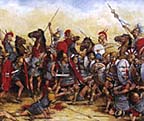 By Douglas Moreman, Southern University, Baton Rouge, Louisianna
By Douglas Moreman, Southern University, Baton Rouge, Louisianna
The Battle of Cannae told in many books on military tactics and strategy violates fundamental principles of war and teaches bad lessons to young officers. Hannibal misled, mystified, and surprised his enemy. He created a sequence of real situations and illusions. Some of his deceptions were so good they have been repeated in histories to this day as if they were facts.
I will describe how the historians and books on strategy have erred in their description of the battle. Briefly, I will correct these flaws:
1) the failure to penetrate all of Hannibal's deceptions,
2) the suggestion that one army surrounded and beat to death an army twice its size, and better equipped,
3) the failure to clearly show all four of the major points where Hannibal achieved, by clever plan, overwhelming superiority of numbers,
4) the claim that 8,000 cavalry blocked the retreat of 70,000 infantry,
5) the failure to explain how Hannibal survived what seems to have been an obvious blunder in the disposition of his troops and of his own person,
6) Hannibal had no routes of escape,
7) A successful general sacrifices sizable contingents of his army,
8) There were not multiple paths to success,
9) Hannibal's plan risked his total destruction upon the rapid success of just one contingent of troops.
Tuesday, July 22, 2003
The Roles of Patrician and Plebeian Women in Their Religion in the Republic of Rome
 By Lesa A. Young
By Lesa A. Young
Political events during the Republic involving women began reforms that eventually changed women’s roles: a Vestal buried alive in 337 BCE, the poisoning trials of 331 BCE, the events surrounding Verginia in 307 BCE, the cults of patrician and plebeian chastity in 296 BCE, and the Stuprum trials of 295 BCE were some of the occurrences. These events were used by women to gain more control over their own lives, money, and property.
As with all Roman law, loopholes allowed the laws to be manipulated to suit the individual. The usus types of marriages were the most common and could be manipulated legally through loopholes by the wife staying away from home and her husband for three consecutive nights a year. Also, these loopholes allowed the women to
retain control over their dowries in trust for their daughters.
Monday, July 21, 2003
Edward Gibbon: Historian of the Roman Empire
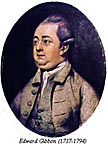 By Eugene Y. C. Ho, Hong Kong (1960-1997)
By Eugene Y. C. Ho, Hong Kong (1960-1997)
"It was at Rome, on the 15th of October 1764," Gibbon later recalled, "as I sat musing amid the ruins of the capitol, while the bare-footed friars were singing vespers in the temple of Jupiter [presently the Church of Santa Maria in Aracoeli], that the idea of writing the decline and fall of the city first started to my mind...."
The work envisioned eventually captivated thousands of historians and laymen alike. Ho explains why.
"First, the greatness and tragical character of the subject catches the attention and arouses the imagination and sympathy of its reader, who finds himself at once introduced to a time most fondly wished for by Man, when most civilised people were peacefully united in "the period in the history of the world, during which the condition of the human race was most happy and prosperous" (Decline and Fall, Ch. 3). Yet, Man somehow lost this grace and now continuously wonders why. In an attempt to ascertain the reason, people turn to Gibbon for enlightenment. Second, for the Western Man in particular, there is here a unique fascination: for out of the ashes of the Western Roman Empire were born the modern nations of Europe, while out of the belated fall of the Eastern Roman Empire came sparks which lit Europe's beacon of humanism and science. Seen in this light, although the Decline and Fall concerns Rome, it is really an ancient history of Europe and European civilisation, and any Western reader is therefore bound to find in this work illumination regarding his origin and roots.
"Originally published in Issue 30 (Apr - Jun 1994) of the Hong Kong intellectual journal Intellectus, Mr. Ho's essay was written to commemorate the bicentennial of the death of Edward Gibbon (1737-1794)."
Friday, July 18, 2003
Decius First Emperor to Die Fighting a Foreign Army
 Decius served as consul in every year of his reign and took for himself traditional republican powers, another way to underscore his authority and conservatism. He even tried to revive the long defunct office of censor in 251, purportedly offering it to the future emperor, Valerian. Decius moreover portrayed himself as an activist general and soldier. In addition to leading military campaigns personally, he often directly bestowed honors upon his troops, high and low alike. He also holds the dubious distinction of being the first emperor to have died fighting a foreign army in battle.
Decius served as consul in every year of his reign and took for himself traditional republican powers, another way to underscore his authority and conservatism. He even tried to revive the long defunct office of censor in 251, purportedly offering it to the future emperor, Valerian. Decius moreover portrayed himself as an activist general and soldier. In addition to leading military campaigns personally, he often directly bestowed honors upon his troops, high and low alike. He also holds the dubious distinction of being the first emperor to have died fighting a foreign army in battle.
Thursday, July 10, 2003
Etruscans Considered Origin Of The Toga
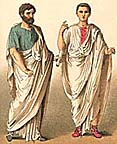 The toga, the principal outer garment worn by the Romans, is derived by Varro from tegere, because it covered the whole body (v.144, ed. Müller).
The toga, the principal outer garment worn by the Romans, is derived by Varro from tegere, because it covered the whole body (v.144, ed. Müller).
Gellius (vii.12) states that at first it was worn alone, without the tunic. [TUNICA.] Whatever may have been the first origin of this dress, which some refer to the Lydians, it seems to have been received by the Romans from the Etruscans, for it is seen on Etruscan works of art as the only covering of the body, and the toga praetexta is expressly said to have been derived from the Etruscans (Liv. i.8; Plin. H.N. viii.48 s74; Müller, Etrusker, vol.1 p262).
Gradually, colours began to distinguish class and professions:
blue for philosophers
black for theologians
green for practitioners of the medical arts.
Soothsayers wore an unornamented white toga.
Peasants were allowed only one sober colour.
Officers were allowed garments of two colours
Clan commanders could wear three colours
Members of the Imperial household wore as as many as seven colours.
(Becker, Gallus, vol.ii pp78-88; Ferrarius, de Re Vestiaria; Rubenius, de Re Vest.)
Article by Philip Smith, B.A., of the University of London on pp1134-1137 of William Smith, D.C.L., LL.D.: A Dictionary of Greek and Roman Antiquities, John Murray, London, 1875.
Gaulish-Latin "rosetta" stones help scholars trace language origins
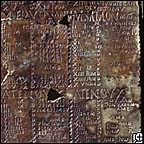 Although the Roman conquest led to the extinction of the Gaulish language 2,000 years ago, a half dozen rare, surviving Gaulish/Latin bilingual inscriptions have enabled scholars to trace the origins of the Celtic language and many other European languages.
Although the Roman conquest led to the extinction of the Gaulish language 2,000 years ago, a half dozen rare, surviving Gaulish/Latin bilingual inscriptions have enabled scholars to trace the origins of the Celtic language and many other European languages.
Peter Forster, a molecular geneticist at the University of Cambridge, and Alfred Toth, a Zurich linguist, applied DNA sequencing and analysis methods to study the inscriptions and corresponding words and word fragments from the following languages: Classical Greek, Old Irish, and the modern versions of Irish, Scots Gaelic, Welsh, Breton, French, Occitan, Spanish and Basque.
Most words were remarkably similar across the board. For example, "mother" in Gaulish is "matir," while in Latin it is "mater." Such similarities in the study were likened to mutations of inherited genes.
"Both the single-wave result and the early dates of (around) 8,000 B.C. and 3-4,000 B.C. confirm Colin Renfrew's archaeologically-based hypothesis, published in 1987, that our languages were brought to Europe and to the British Isles by the first farmers at the beginning of the Neolithic," explained Forster. "These farmers would have come from the Near East via Anatolia (Turkey)."
Findings are published in the current Proceedings of the National Academy of Sciences.
Subscribe to:
Comments (Atom)